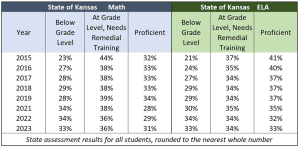Deputy Education Commissioner Dr. Ben Proctor revealed that a new state assessment plan will be given to students during the 2024-2025 school year but said KSDE will not evaluate the results until the school year ending in 2027. However, in response to questioning from The Sentinel, KSDE now says Proctor misspoke, and it will set cut scores within two months and publish results in October.

In his presentation to the State Board of Education, Dr. Proctor defended the new assessment model:
“We believe that by providing a several-year look at the action plan that we’re prioritizing action, and if we’re not onboarding the results right away, we’re giving the district the ability to take those actions that we believe, ultimately, are going to impact those outcomes.
“We need a couple years of assessing students with that new assessment so the state board can set those new cut scores based on those assessment items.”
“Cut Scores” determine where student scores are categorized, which currently are Level 1 (Below Grade Level with limited understanding), Level 2 (at Grade level with basic understanding but needs some degree of remedial training), Level 3 (Proficient with effective understanding and academically prepared for post-secondary), and Level 4 (Proficient with excellent understanding and academically prepared for post-secondary).
Dr. Proctor’s announcement took legislative leaders by surprise.

House K-12 Education Budget Chair Rep. Kristey Williams told The Sentinel:
“This is absolutely unacceptable! They did this despite what we put in legislation,” she said, referring to Senate Bills 387 and 438, each recently signed into law by Governor Kelly. SB 387 included achievement improvement goals based on the current state assessment, while SB 438 established the Kansas Blueprint for Literacy to improve reading scores.
Senate Education Chair Molly Baumgardner questioned the timing of the KSDE announcement:

“It was quite startling that during the entire legislative session, no one from the Department of Education shared that brand new assessments for our Kansas students would be administered starting next year. Even more unusual is that none of the new assessments have been beta-tested to ensure that they align with current assessment outcomes. With already weak scores in reading and math literacy, not having testing continuity with prior years could bring into question the validity of upcoming scores.”
We asked KSDE a series of questions about the new assessment regimen. Responding was Communications Director Denise Kahler:
1 – Dr. Proctor told the State Board that a new state assessment will be implemented for 2025, and the cut scores will be set a couple of years later. Does that mean we won’t know how many students are academically prepared/proficient until cut scores are set?
“Dr. Proctor inadvertently said two years when he meant that cut scores would be set two months following administering the new state assessment. As has been our process, we will bring teachers together in June 2025 to evaluate the new assessment and make cut score recommendations. Those recommendations will be presented to the State Board in July and voted on in August.
“Cut scores have never been set prior to the first administration of a new state assessment.”
2 – Can new assessment results can be compared to current outcomes? KSDE has always said one assessment cannot be compared to another.
“It is unknown at this time. The decision will not be made until the cut score process with teachers is complete, a psychometric analysis determines if the measured constructs changed significantly and the performance level ranges are adopted by the State Board of Education.”
3—That seems to put KSDE out of compliance with legislation that Governor Kelly just signed (SB 387 and SB 438) that references performance on the current state assessment. How will KSDE remain in compliance with laws calling for specific performance (e.g., Level 2+ (90% in the literacy blueprint)?
Kahler would not answer that question.
KSDE avoids accountability for poor state assessment outcomes
Kansas Policy Institute CEO Dave Trabert says this is another example of KSDE and the State Board of Education attempting to evade responsibility for improving student achievement for approximately one-third of students who are below grade level in reading and math.
“KSDE changed definitions to contend that students in Level 1 are not below grade level. The State Board’s accreditation standards require districts to comply with state laws, but it takes no action even when audits find districts not spending at-risk funding as required by state law. Creating a new state assessment appears to be another attempt to avoid accountability for poor outcomes.
 “With no demonstrated need to replace the current state assessment, this appears to be a conscious effort to run away from results of the current assessment and start over.
“With no demonstrated need to replace the current state assessment, this appears to be a conscious effort to run away from results of the current assessment and start over.
“Education officials said insufficient funding was needed to improve achievement. But outcomes are worse after a court-ordered $1 billion increase, having gone from 23% to 33% below grade level in reading, and from 21% to 33% below grade level in math.”



